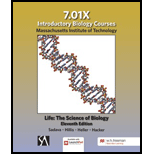
Concept explainers
To review:
The decrease in the number of radio-labeled cells in the zones of cell division and cell elongation over the time.
Introduction:
The undifferentiated mass of cells that has the capability to divide and give rise to a new plant is called as meristems. The meristems located at the apex regions are referred to as the apical meristems that are found at the root apex (root apical meristem) and shoot apex (shoot apical meristem).
Explanation of Solution
Introduction:
Root apical meristem (RAM) is responsible for the generation of cells that help in the development of root for the absorption of water from the soil. The tip of the RAM contributes to the formation of the root cap, which protects the soft tissues of root from damage and also helps in the penetration into the soil. The middle portion of RAM is the quiescent center, which consists of a mass of cells that are held at the G0 stage of the cell cycle, but can enter G1 phase and undergo division when required.
The apical portion of the RAM gives rise to three distinct zones. The zone of cell division is present just above the quiescent center, which possesses the actively dividing cells giving rise to primary root tissues. Above this, zone of elongation is present where the cells are continuously elongating in size. The zone of cell maturation is present just above the elongation zone. Here, the cells are not dividing anymore and get matured and differentiated to perform a specialized function.
In an experiment the growing root tips of the plant were incubated in radio-labeled thymidine solution to identify the dividing cells in roots, the thymidine is incorporated in DNA and gets labeled. Later, when the labeled cells were put in the solution containing nonlabeled thymine, the number of labeled cells decreased in the zone of division and elongation of the root. This is because the cells of zone of division and elongation actively took up the labeled
Hence, there was a decrease in the labeled cells in the division and elongation zones and increase in the zone of maturation when incubated long in the solution of nonlabeled thymidine solution. This is so because during the
Want to see more full solutions like this?
Chapter 33 Solutions
LIFE:SCIENCE OF BIOL.(LL) >CUSTOM<
- Why is it important for chromosomes to be condensed during mitosis anddecondensed during interphase?arrow_forwardAlso, In the figure above, what differences in the pattern of cell division can we observe between the regions labeled (1) and (2)?arrow_forwardIn the cell shown by the green arrow (the top arrow), which step of mitosis is occurring?arrow_forward
- How is the process cell division related to the phases of the cell cycle ?arrow_forwardwhen does the cytokinesis start and what is the shallow groove called that indicates cell division?arrow_forwardBetween which two stages of the Neurospora life cycle do most mitotic cell divisions occur?arrow_forward
 Human Heredity: Principles and Issues (MindTap Co...BiologyISBN:9781305251052Author:Michael CummingsPublisher:Cengage Learning
Human Heredity: Principles and Issues (MindTap Co...BiologyISBN:9781305251052Author:Michael CummingsPublisher:Cengage Learning
